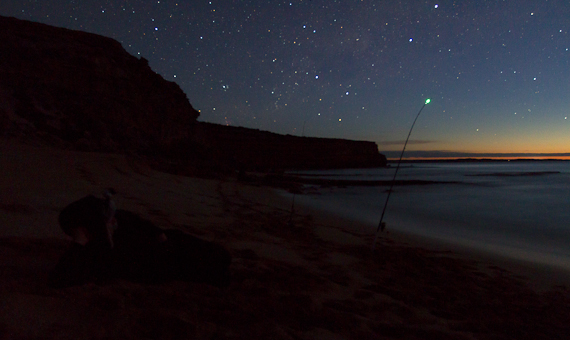 |
| Waiting for a bite at night |
Getting Creative in the Dark
Most people put their cameras away when out fishing once the sun goes down unless taking happy snaps of a significant catch. I too was mostly guilty of this in the past. I had made a few attempts once or twice at getting an interesting shot at night, and have had varied success. On an overnight trip to the bottom of South Australia's Yorke Peninsula last weekend, I carried a tripod in to shoot some wide angle landscapes. When I opened my camera bag, to my horror I discovered that in my haste I had not swapped the len which was on my 7D over for the wide angle zoom. Instead of having a 17-40mm and 70-200mm with me, I had no focal length shorter than the Sigma 50mm f1.4 which was on the camera body. The 50mm focal length is considered a "normal" lens on 35mm film and full frame digital. As the 7D has a cropped frame sensor, the lens angle of view gives a short telephoto perspective, and was therefore useless for the types of images I had in mind. I did shoot a few frames of the cliffs that you can see in the image above as the sun was setting, however my efforts were a little rushed and half hearted as I did not have the lens I had planned to use.
Since I had carried the tripod in, I figured I had better get more than a few minutes use from it, so after the sun set, the sky darkened, and the cloud cover mostly disappeared to reveal the stars; out came the camera again. Using the tripod, a slow shutter speed, and the fast aperture of the 50mm f1.4 lens, I did my best to roughly compose through the viewfinder (no preview image was available on the cameras LCD screen in liveview mode as it was much too dark). I then turned on liveview and used the electronic level to try and get the horizon relatively straight. I made a number of images using this and similar techniques. I am the first to admit they could be improved, but for me this was a whole new idea. In Part 2 I will go through how I went about experimenting that night, and will share a few more images that were created as a result.

























